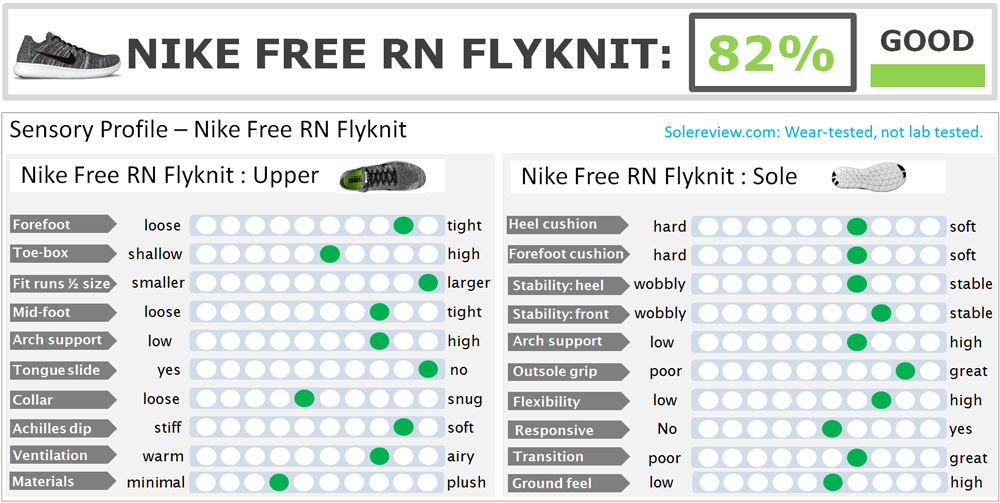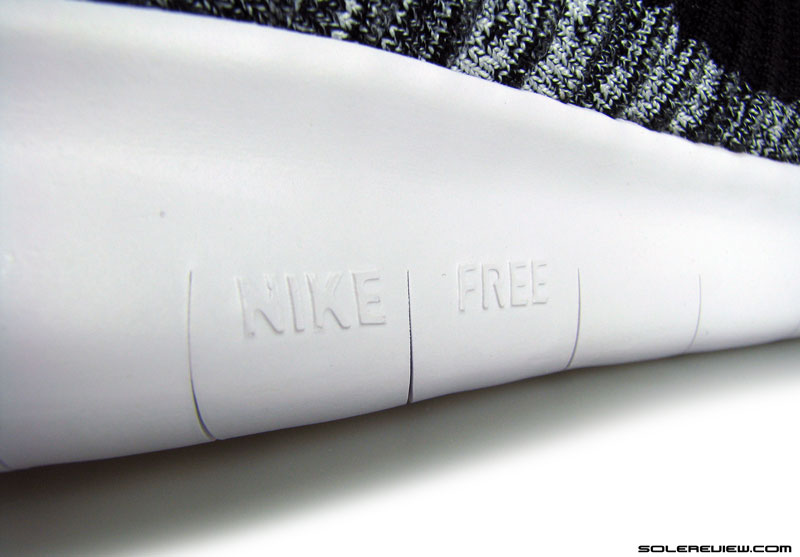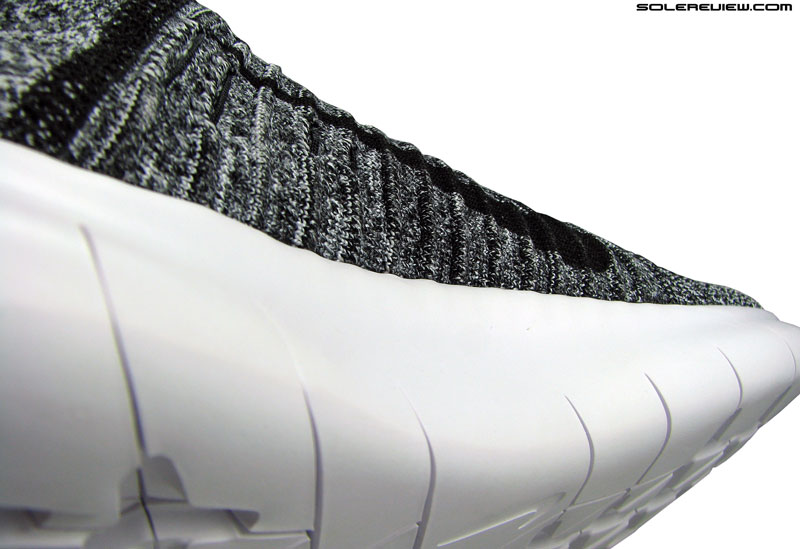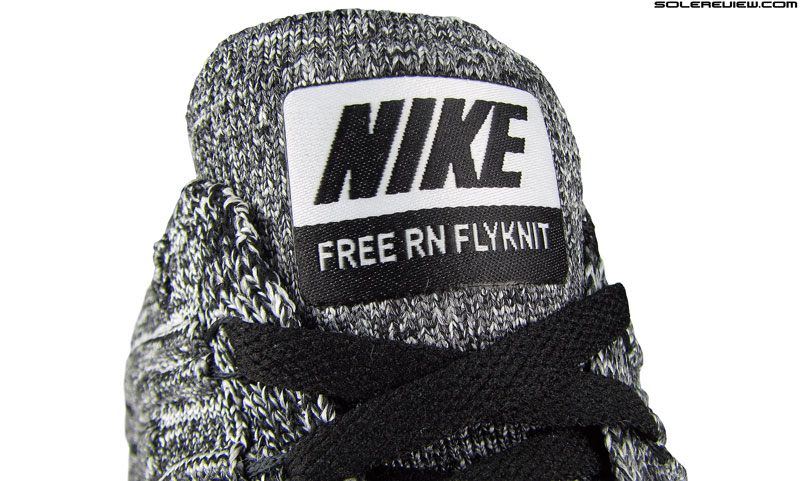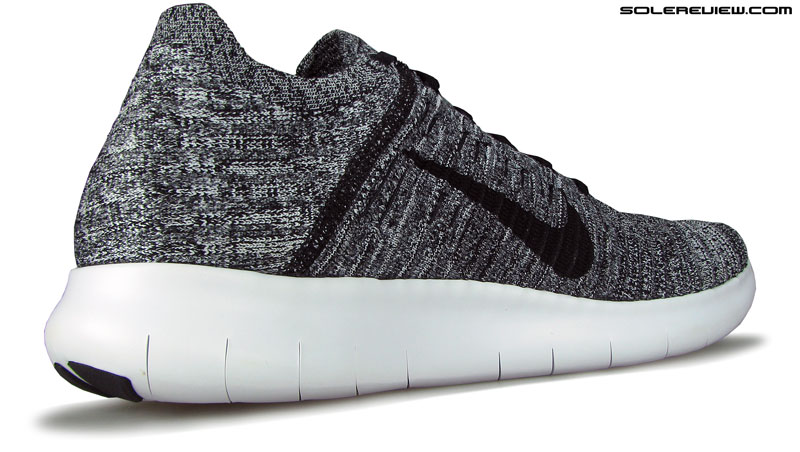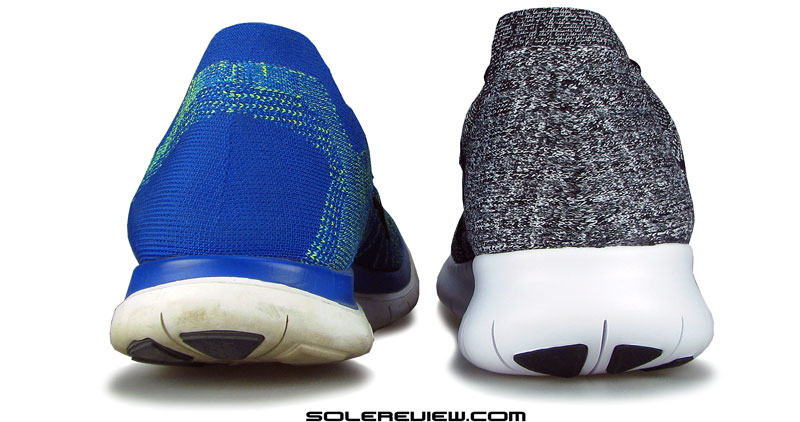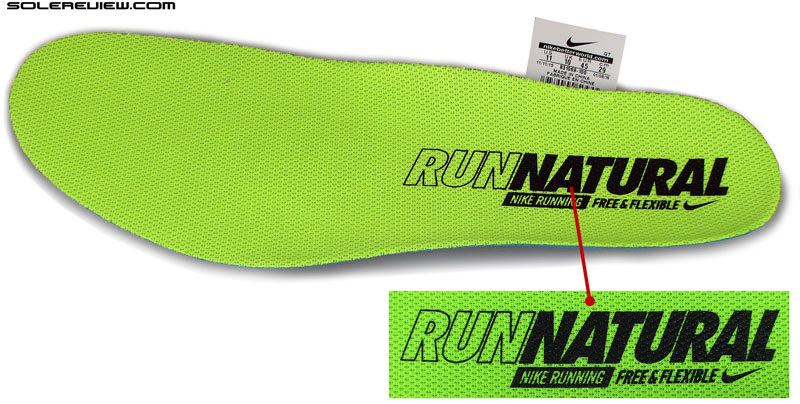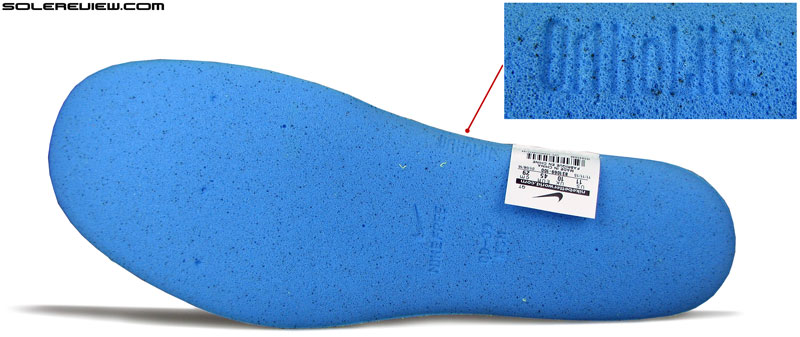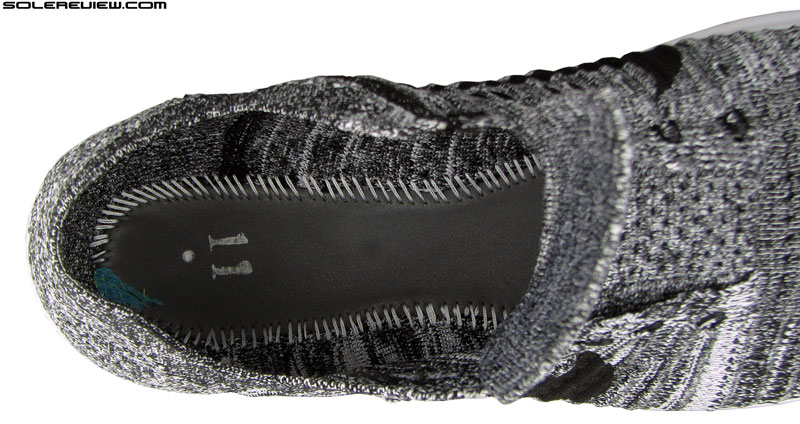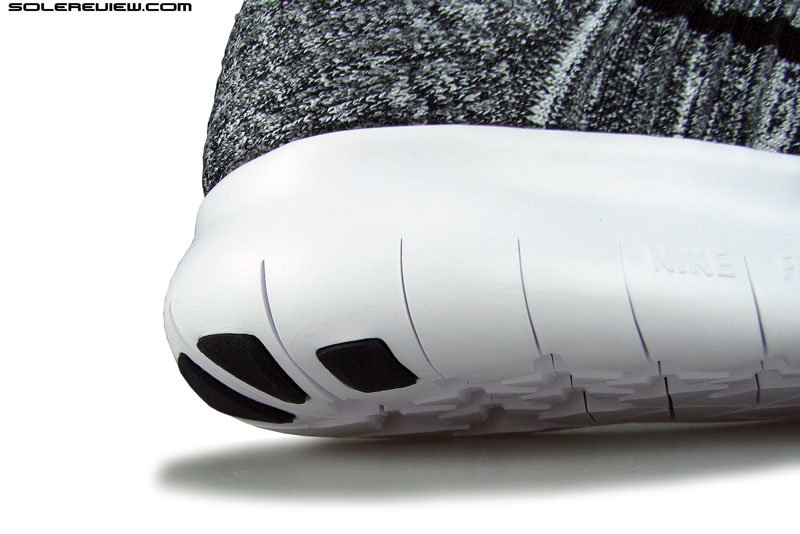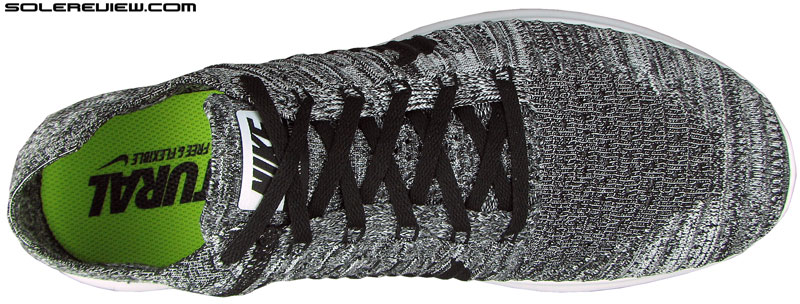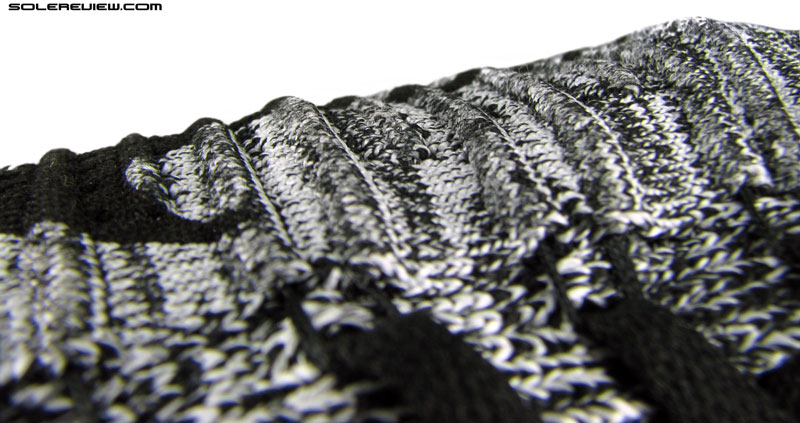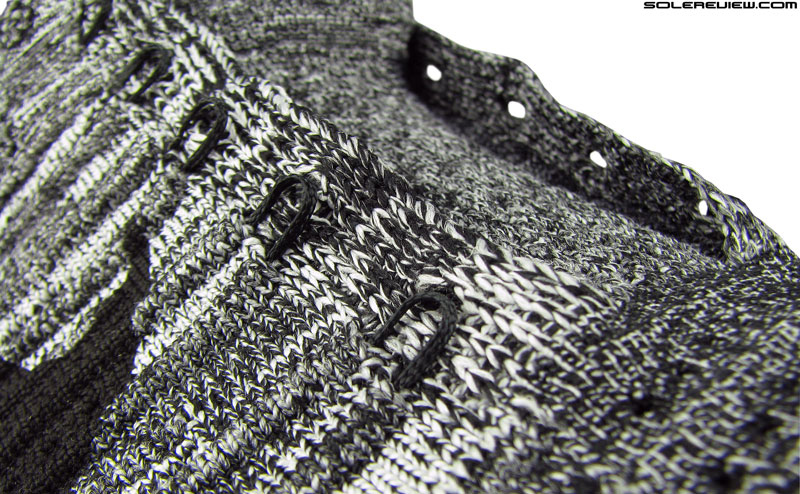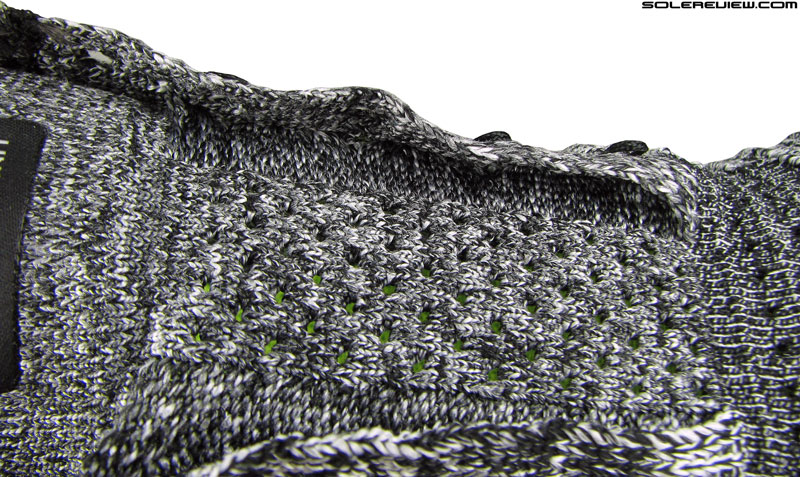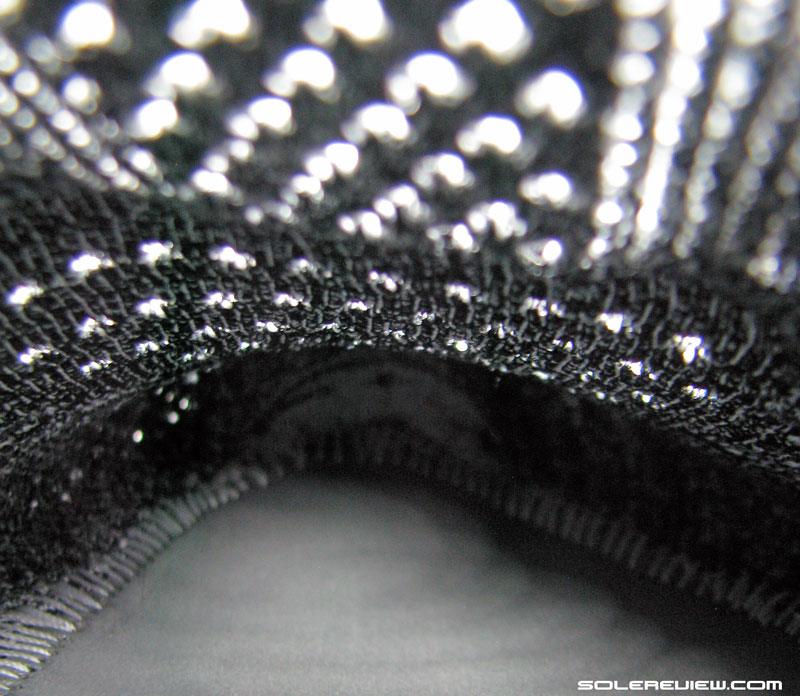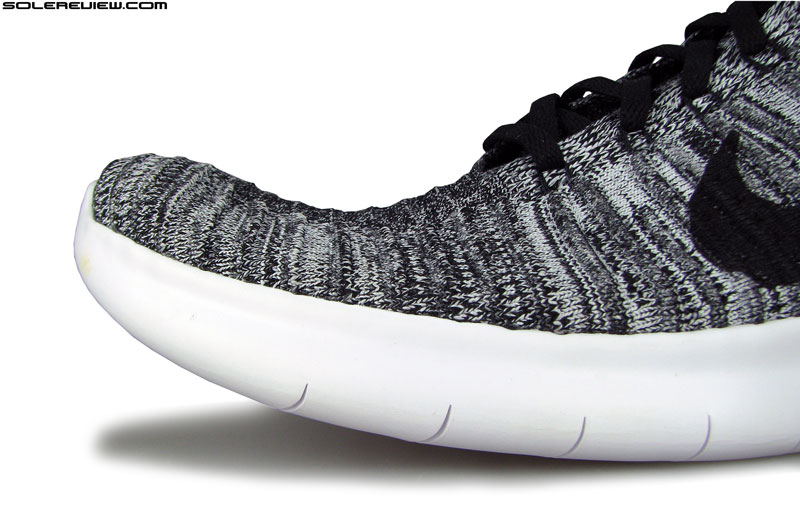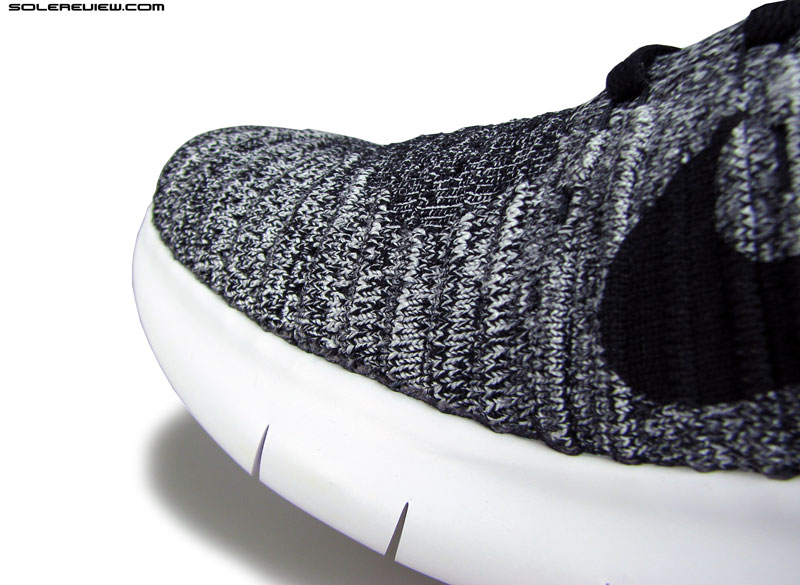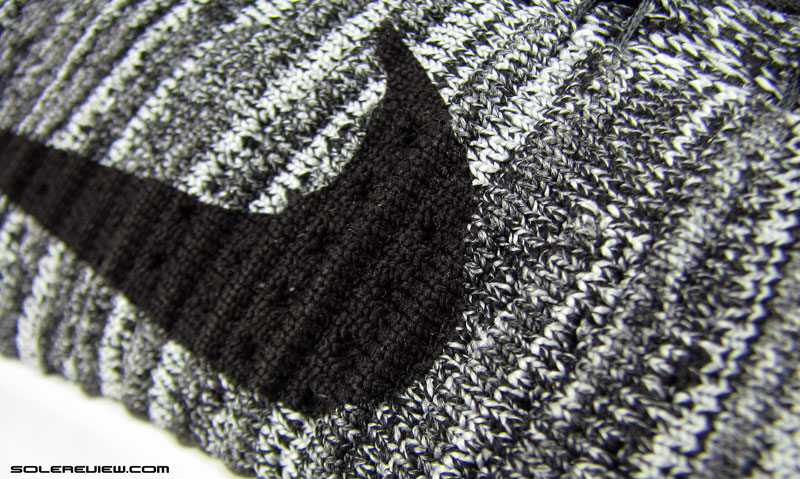This is the first year in Nike Free’s history that hasn’t seen a release of a Free model with the numerical suffix. Historically, Nike Free had always been characterized by the numbers a particular model was associated with.
This graphic represented which level of minimalism each numbered model stood for. This topic has been discussed at length on solereview, so we will skip writing about it again. Read this review if you want to know more.
Replacing the numbered Nike Free line-up is the new RN assortment which consists of four models. At the very top is the $150 Nike Free RN Motion Flyknit, which combines a bootie Flyknit construction (modeled on Free 3.0 Flyknit) with a dual density, soft foam topped midsole.
Below that is the $130 Free RN Flyknit with its single density midsole, a shoe which we’re reviewing today. And then you have two non-Flyknit Free shoes, which happens to be the $120 RN Distance and the entry level $100 Free RN. All other Free models such as the 3.0, 4.0 and 5.0 are now officially shelved; any remaining inventory is being offered at close-out prices.
So four shoes, and four price-points. What is the difference between them?
This can be simplified by dividing the new Free assortment into two groups – Flyknit and non-Flyknit uppers, and then into further sub-categories of soft and firm cushioning.
On the Flyknit side of the things, you have the Motion and RN Flyknit. The RN Motion has a dual density midsole with a softer foam core, while the RN has a firmer, single density midsole.
When you look at the non-Flyknit assortment, the same distinction applies. There is the RN Distance with its softer Lunarlon insert, which is a softer version of the single density midsole.
So your decision making process should boil down to two things – 1) whether you want a Flyknit or non-Flyknit upper 2) your preference of a soft or firm midsole.
We must mention that none of the Nike Frees from the 2016 line-up are direct replacements for the outgoing Free (3.0, 4.0, 5.0) versions. Sure, there exists a strong element of design sharing, for both assortments utilize the flexible Free platform and single piece uppers.
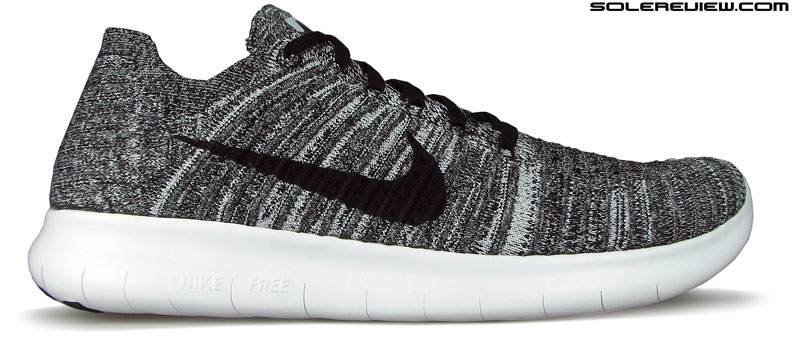
There are some shared qualities with the Free 4.0 but know that the RN FLK is not a direct replacement.
Though the Free RN Flyknit isn’t the official successor to the outgoing Free 4.0 Flyknit, we’ve decided to throw in a comparison. Based on what we’ve been reading so far, a lot of runners think the Free RN Flyknit to be a 4.0 substitute.
We thought it would be a good idea to talk about the areas in which the new shoe resembles the 4.0, and vice versa.
There’s one theme which runs common across the new Free models, and that’s the increased level of midsole cushioning. Historically, Nike Frees have been known for their low profile, ultra-flexible midsoles with a noticeable ground feel. Till recently, Nike Free shoe stayed clear of cushioning inserts, keeping the ride quality firm and flat.
However, with the winds of change blowing towards the direction of cushioned midsoles, Nike has tweaked their product strategy. Suddenly, you have Nike Free shoes with a soft Lunarlon insert (RN Distance) and soft foam cores (RN Motion). Not to be left behind, other Nike Frees up their game in cushioning too.
The Free RN Flyknit is a good case in point. The midsole design evolution is made very clear when you look at this side-by-side picture of the Free 4.0 Flyknit and the Free RN Flyknit.
Clearly, not only does the RN version has taller stack heights, but more foam volume as well. The foam material used on the RN Flyknit is softer than before.
As always, midsole materials and stacks form only a part of the story. Enhancing the Free RN’s soft cushioning feel is its updated outsole design. Hexagonal grooving was introduced just a couple of years ago, and guess what, it’s already on its way out. Replacing that is the new triangular lug pattern which Nike calls the ‘Tri-star’.
Regardless of the etymologically incorrect ‘Tri-star’ ( a star has five points, not three) name, the new lugs do three things (in that case, Tri-star is apt) differently than the hexagonal layout.
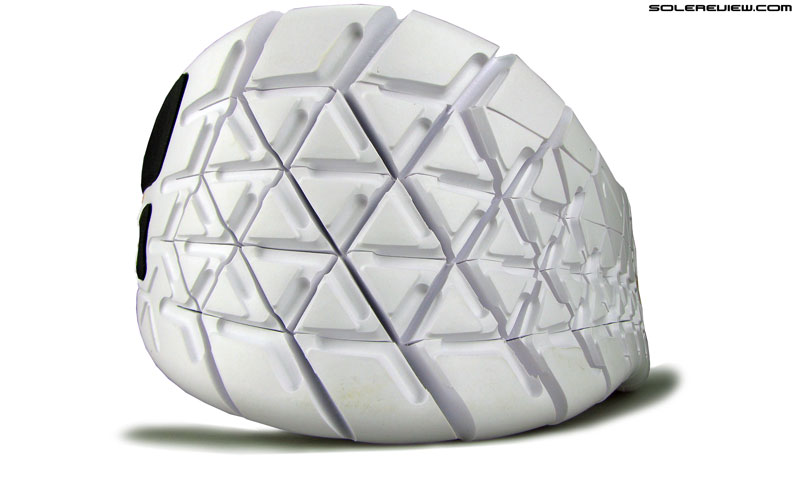
Outsole lugs are now triangular and raised. The result? Greater responsiveness and cushioning feel. Less of the pebble trapping too.
To begin with, the lugs are raised elevations over the midsole. By now, you must have read enough reviews on this site to know what that does. Each lug acts as a piston of sorts during running, and in the process increases the cushioning feel.
This sensation is more prominent under the heel where the lugs are smaller, compared to the forefoot where the foam nubs are relatively flat and larger in size.
And with each lug acting independently as a piston, the ride ends up becoming more responsive. That’s the rebound effect of the foam lugs at work here. That is why the Free RN Distance (with its hexagonal lugs) rides differently than the other RN models.
It must be mentioned that where the 2015 RN Distance lacks in responsiveness, it makes up in cushioning softness. The RN Distance has the softest Free midsole out of all the Free shoes we’ve reviewed to date.
Rest of the cushioning components like the foam lasting and removable insole are borrowed from the 4.0. The Ortholite branded blown foam insole is exactly the same, and so is the sheet of grey foam below it.
Secondly, the independent lugs result in a much better quality of outsole grip than the flatter profile of the previous Nike Free’s.
And lastly, the new design is less prone to trapping debris than the hexagonal design. The raised lugs are liberally separated by open spaces big enough not to trap debris. That said, there are sections of flat areas where you’ll see small pebbles and its ilk lodged.
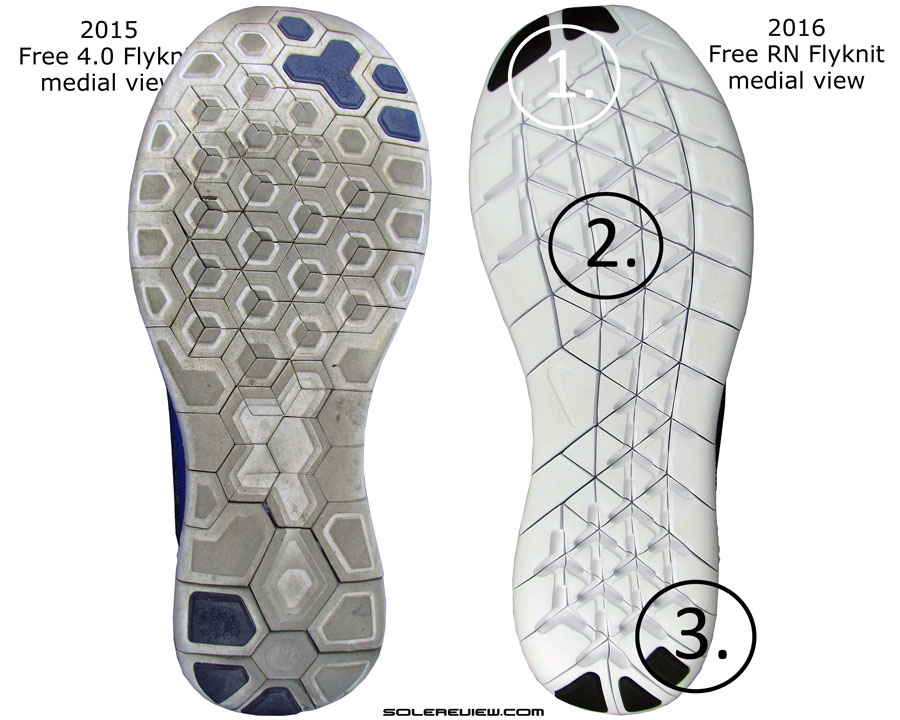
1) and 3): Poor placement of rubber bits. Those aren’t high wear areas. The Free 4.0 (left) had a much better design. 2) The raised lugs increase cushioning feel and reduce the instances of lodged debris.
There are pieces of rubber pasted on the outsole but frankly, their placement indicates poor footwear design. The ones under the front are way out near the tip, and the rubber pieces on the rear are too close to the heel edge.
Unless one has a very bad or strange running form, these areas aren’t high wear areas at all. For somebody to make use of the heel rubber on the RN Flyknit, one would have to over-stride in a manner of an exaggerated heel-strike.
It seems that brands simply resets the whole design cycle each year, without giving much thought to past best practices. Because if Nike had done so, they would have looked at last year’s excellent Free 4.0 (and 5.0) and borrowed some cues on how to design the RN outsole.
Nothing makes this clearer than having a look at how the Free 4.0 or 5.0’s outsole was laid out. Under the heel, the rubber parts were laid out in actual high wear areas.
There was a large flat piece under the rearfoot, followed by smaller pieces towards the edge. This pattern was also followed on the Nike Free 5.0 and RN Distance.
In contrast, the RN Flyknit starts with the smallest piece first, and even that isn’t under the correct wear area. The largest piece of rubber now sits on the outside medial edge. This renders the heel rubber bits functionally useless, and they are just bits of decorative garnish.
Most runners wear out their outsole under the medial forefoot, and the RN Flyknit does not fortify this area. Instead, the rubber pieces are placed right under the toe-spring – another example of throwing basic footwear 101 to the wind.
So why this inconsistency and poor design? We can only guess, but it might have to do with changing footwear designers. The design team working on a particular product line (say the Free) this year might not be the same the next, so the evolution gets lost somewhere.
Of course, there are processes in place for project hand-offs and briefing, but ultimately the new designer might go and do his or her own thing.
That disconnect is also evident on the Nike Free RN Flyknit’s upper design. Ideally, the RN Flyknit should have used the excellent 4.0 Flyknit’s upper fit template as a base to further improve the upper. While some parts retain 4.0 Flyknit’s design legacy, certain updates are puzzling.
What’s similar is a Flyknit format which combines the knit mesh with a tongue flap. This is different from the sock-like Free RN motion or the earlier Free 3.0.
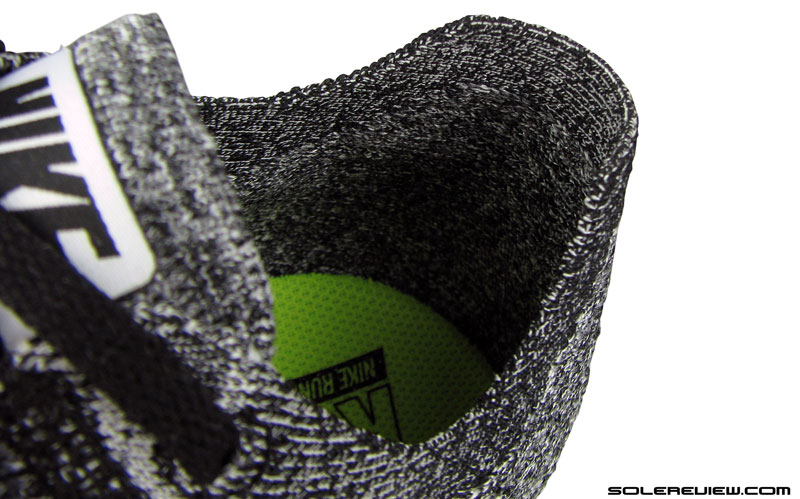
Like most Flyknit based models, the heel is deconstructed – no lining, foam or support counter. In fact, it even has a case of mild elasticity.
The RN Flyknit has familiar visual scenery. Flywire loops are embedded in the upper ribs, and help cinch laces without digging into the sides. The tongue flap has some freedom of movement – despite being part of the single piece upper which is joined by a solitary medial heel seam.
The heel collar is completely deconstructed and contains neither foam fill or counter.
Regardless of the familiarity , the 2016 Free RN Flyknit has a very different quality of upper fit. For starters, the shoe happens to run at least half size larger in length. Assuming that the last used is identical (to other Frees), there can be only one logical explanation.
It’s most likely the heel area at work, which moves the foot’s position away from the front. There’s also the far-fetched possibility that the deeper grooving of the new outsole geometry splays out wider and increases its length.
Anyway – the end result is that the shoe is a half size larger. If you wear a US 9 , you should get a US 8.5 and so forth.
The forefoot is also very narrow and shallow, which is at odds with the roomy toe-box. Most pictures you see of the Free RN Flyknit online isn’t a correct representation of the actual fit. Even solereview’s photo-shoot process involves stuffing the shoe with teddy bear filling (poly-wool) in order to achieve shape uniformity.
Remove the filling, and the Free RN Flyknit looks exactly like this:
This clown toe appearance owes itself to a couple of factors. The vented portion of the forefoot top has more stretch than say, a Free 4.0 Flyknit, so that cranks up the snugness a few levels. In addition, the forefoot on either side is made of the rib reinforced mesh.
This material has zero stretch properties, and when combined with the vented (elastic) mesh, the forefoot ends up being super shallow.
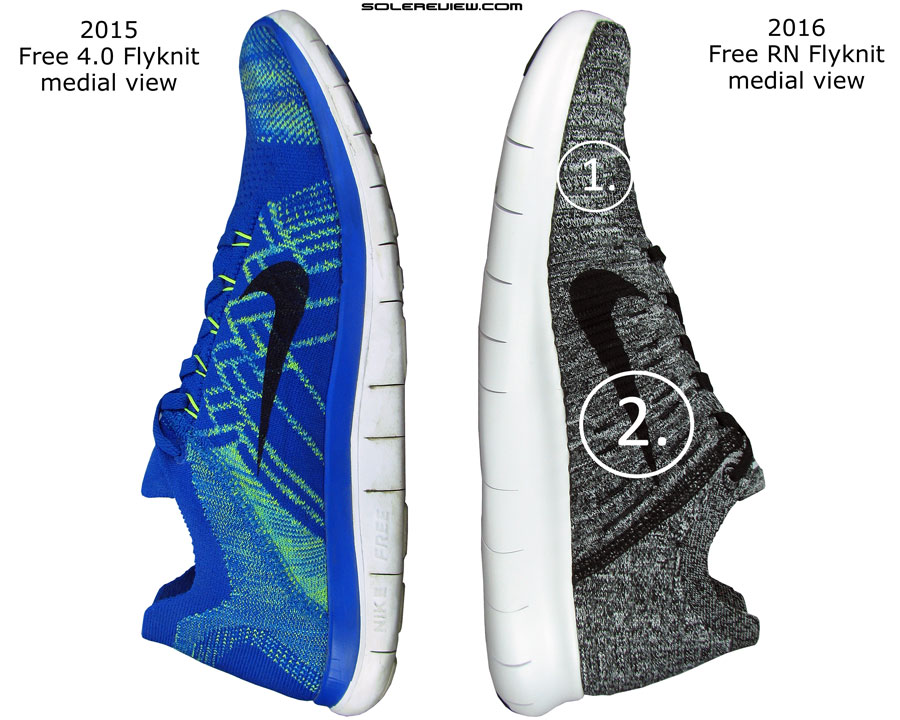
1) The Free 4.0 (left) had a stretch panel on the medial forefoot side. The RN Flyknit (right) doesn’t. 2) The midfoot panels are stiffer when compared to the 4.0.
Why wasn’t this an issue on the Free 4.0 Flyknit? Because the medial forefoot was thoughtfully designed (see image above) to include a stretch panel, and the mesh did not have ribs running over them. Nor was the ventilated forefoot top snug like on the RN Flyknit.
Look, there’s nothing wrong with a snug forefoot. Historically, many Free Flyknit models have had a much narrower forefoot. The new RN Flyknit is nowhere as tight as some of the earlier Flyknit executions such as the Free 3.0 and 5.0 Flyknit.
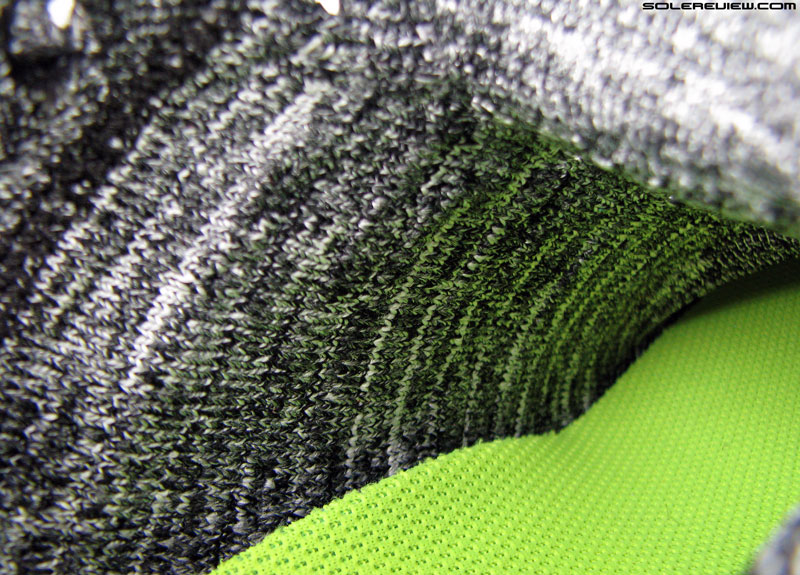
The midfoot is comparatively relaxed in fit. As the upper progresses towards the forefoot (see the shallow ceiling in the front), the fit becomes much narrower.
It is just that the forefoot fit seems disconnected from the rest of the upper, which happens to be easy and relaxed fitting. If Nike’s product goal for this shoe was to make it appeal to a broader audience, then it would have been wise to just use the Free 4.0’s tried and tested fit and apply a few visual updates.
In our opinion, the Nike 4.0 Flyknit (both years) had the best combination of Flyknit and Free, blending both in moderation.
There’s another aspect we aren’t sure about. We recommend buying a half size smaller, so will that make the forefoot even tighter? Can’t say.
But like we said in our disclaimer, this is a new breed of Nike Free. The RN Flyknit (and its brethren) trades a purer, connected ride experience for a more insulated, cushioned one.
That makes the shoe feel like less work to run in, and you can go longer distances thanks to the midsole which is not only thicker but softer from a material perspective. In a departure from the flat ride of prior Free models, there’s enough cushioning here regardless of your footstrike. The raised midsole sidewalls cup the foot, making good on the support aspect too.
The new RN update across the line will lose a few customers and gain new ones, and that has always been the nature of the beast.
(Disclaimer: This is a reader supported review – the shoe was bought at full US retail price by one of our readers and donated to solereview.)

